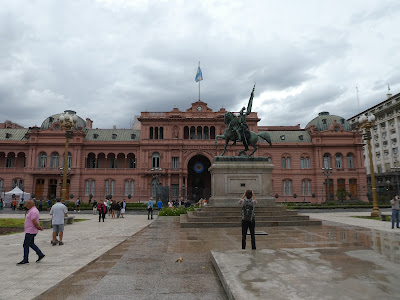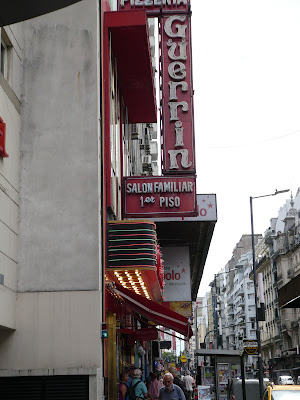"Antarctica?? Why do you want to go there?" We heard this phrase ALOT when we started telling friends and family where we were headed on our next adventure.
It was a destination that we had not even thought about until we started seeing photos and hearing stories from fellow travelers who always ranked this trip to be one of their all-time favorites. We got interested and started thinking...and then ran across this quote from Eleanor Roosevelt:
"The purpose of life is to live it, to taste experience to the utmost, to reach out
eagerly and without fear for newer and richer experience."
So, what else could we do? We had to discover for ourselves the pristine beauty of this great white wilderness and 7th continent of the world, even if it meant crossing the Drake Passage, which can have the most violent seas in the world.
Our adventure begins on the day after Christmas, 2019, when we headed to South America to meet our tour group with Overseas Adventure Travel.
Our first destination is Buenos Aires, Argentina.
It's an overnight flight; we arrive about 7:30 am.
After going through Passport Control at the airport we are met by an OAT representative and a driver who whisks us off to our hotel, the Panamericano, located just a block from this obelisk, the most iconic monument of Buenos Aires.
It's only late morning, but we are able to check in to our hotel room and relax a bit after a day and night of air travel.
Late in the afternoon we meet our Trip Experience Leader, Marta, and our fellow travelers. Our group includes 22 people. Marta gives us an informative briefing about our trip...
...and we toast to a wonderful adventure with the welcome drink of Argentina.Then it was on to a local restaurant for our Welcome Dinner at a traditional Argentine steakhouse. Argentina is known for great beef and we were not disappointed!
After dinner Marta led us on a walk along the Rio de la Plata River and across this bridge, named the Women's Bridge.
It's design symbolizes the dance of Tango, the most popular Argentine dance, where the strong man supports the woman who leans back in his arms.
The next morning we join our group on a City Tour. We have been to Buenos Aires twice before and have seen many of the sites but seeing them again is no problem for us, plus it gives us a chance to get to know our fellow travelers. Here's a few photos of what we visited:
First we head to Plaza de Mayo to see the famous "pink palace", Casa Rosada, the official Presidential Office in Buenos Aires, and where Juan and Evita (Eva Peron) addressed the masses from the balconies in the late 1940s and where Evita sang "Don't Cry for Me Argentina" in the movie Evita.
Then we walked across the plaza to the Metropolitan Cathedral
where Pope Francis used to perform mass as Archbishop Jorge Bergoglio before assuming his duties in the Vatican in 2013.
This monument in the plaza honors Argentina's Independence Day, May 25, 1810.
We saw many mosaic white scarves in the pathway around the monument. Our local guide and Marta explain the significance of the white scarves, which represent the Grandmothers of Plaza de Mayo.
The Grandmothers of the Plaza de Mayo is a human rights organization of Argentine grandparents whose children "disappeared" during the military dictatorship, between 1976 and 1983. They organized while trying to learn what had happened to their children and grandchildren kidnapped during the repression, and began to march in 1977 at the Plaza de Mayo.
The adult children had been killed; the babies and children were illegally adopted by families of the right-wing followers. The scarves commemorate those that disappeared and the grandmothers who are still in search of their grandchildren.
Back on the bus, we drive to the neighborhood of La Boca, Buenos Aires' first merchant and fishing port. Between 1880 and 1930 about 6 million people immigrated to Argentina. About 50 percent were from Italy, many from the port town of Genoa.
We stopped and strolled through the Caminita streets where we saw tango dancers and artists and colorful buildings. The houses here represent the neighborhood's typical tenement shacks, covered in corrugated metal and originally brushed with leftover paint that Genoese port workers got from the ships.
Numerous mannequins hang from balconies of the brightly colored buildings looking down at the street. Several portray famous Argentinean personalities.
Caminito (or "little path") was named after a 1926 tango song, which tells of a love lost. This song inspired Benito Quinquela Martín, La Boca's most famous artist, to help create Caminito in 1955.
They performed a couple of dances for us.
And sure enough, it was then time for our group to have a tango dance lesson.
Oh, yeah, we can do that!
We all tried, and with the addition of a red scarf for the women and a fancy hat for the men, we felt like we had mastered the tango....NOT! But we gave it a good try and had fun.
The last stop on our city tour was to the Recoleta Cemetery. It is considered one of the most unusual cemeteries in the world and a must-see stop for any visitor to Buenos Aires.
Most of the graves are built above ground and include elaborate carvings and marble pillars. This photo is from the internet to show an aerial view of the cemetery.
It is very plain considering the elaborate graves nearby.
The most interesting thing about her grave has to do with how long the government hid her body before finally interring it in the Recoleta Cemetery – it only took 20 years. “Evita lies five metres underground, in a crypt fortified like a nuclear bunker, so that no one should ever again be able to disturb the remains of Argentina’s most controversial First Lady.”
We then wandered through the maze of tombs
and stopped for a couple of interesting stories:
This one is for Liliana, who was honeymooning in the Alps when she and her new husband were killed in an avalanche. Her grave is said to have been modeled on her childhood room and is made entirely out of wood and glass, not a stone used, presumably in silent protest of the killer avalanche.
And then there's this one that will give you a chill: Rufine was buried in 1910 at 19 years old believed to have died while in a coma.
But grave-workers heard her screaming from the grave. When they dug her up, they reportedly saw evidence that she had unsuccessfully tried to claw her way out. A claustrophobic person’s worst nightmare!
By now it was time for lunch and our Trip Leader suggested we all go to her favorite pizza restaurant near our hotel.
Argentina is not only known for its beef, but also for pizza and pasta due to the large population of descendants of Italian immigrants. You can see the pizza is very, very cheesy. There's actually a sampling of another pizza on top of this one for us to try. It was all very good.
Terry ordered a "large" beer. What came was an entire pitcher, which he thankfully shared with our tablemates...we still had more to see this afternoon.
That afternoon we had reserved tickets for the Opera House tour with our "traveling buddies", Margaret and Ken. They live in our same town and we traveled to Egypt and Morocco with them last year.
This is looking up while standing in front of the huge staircase. The stained glass is French.
Here's the Golden Hall, a permanent center for chamber music concerts. The ornate architecture is a mix of Italian and French.
In this hallway there are carvings of famous musicians, like Mozart, adorning the doorways.And finally, what they call the "Room". It is famous throughout the world for its acoustics and decorative richness. Luciano Pavarotti once said he dreaded performing in this majestic theater--the acoustics are so perfect, he said, that he could hear his every mistake! The stage is set for the evening performance of Swan Lake.
Well, that about takes care of a quick visit to Buenos Aires. One more thing we thought was interesting was some signage:
This one indicates that there is a school nearby so watch out for children.
This one was most disturbing. It warns of human trafficking. Do not smuggle people in suitcases.
The next day we leave Buenos Aires and fly to Ushuaia. The city at the "end of the world" and our jumping off point to head to Antarctica, where we board an expedition ship to cross the Drake Passage.
To continue reading, scroll down and click on "Newer Post".












































No comments:
Post a Comment